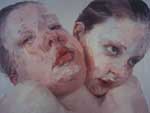
The elephant dung may have generated the headlines at the “Sensation” show in Brooklyn, but the nudes of Jenny Saville – which are also part of the Brooklyn show – are attracting the most comment among painters. The vogue the 29-year-old English artist is enjoying is not simply the result of talent; many artists as skillful with the brush are routinely ignored. Nor is it a matter of her being more or less original. Saville is deeply indebted to other English artists, notably Lucian Freud, yet is not chastised for being derivative. She is flourishing because she has found a way – in her treatment of large nudes – to give form to powerful underlying expectations in the art world about both art and the body.
“Territories” is the title of her current exhibition at the Gagosian Gallery in SoHo. The word aptly evokes the rolling fields of corpulent flesh that fill her paintings (and give new meaning to the phrase fat of the land). In this show, which runs until December 18, she is presenting five paintings of nudes and one close-up of the heads of two children. Like Freud in his late pictures of disturbingly large people, Saville forces the viewer to confront, not just observe, the bare facts. She will often cant the perspective of a painting until the bodies seem to rise above the eye like unstable mountains. The paint itself seems pungent, giving every bruise, pucker, and sore a physical presence. But Saville also differs from Freud in ways that meet the demands of contemporary taste. If Freud is regarded as an old-fashioned realist and easel painter – despite his sexually fraught subject matter – Saville is viewed as an artist entirely in keeping with her times. She works from images rather than models, giving her art a touch of the photographic. She has a feeling for today’s scale; she seems less an easel painter than a maker of baroque billboards. Her brushwork is lighter, looser, and more melodramatic than Freud’s; there is even some pink playfulness – a touch of rococo – in her work. Traditional realism is challenged when she occasionally employs varying points of view in the same picture (the figures themselves are often composites of several bodies) or calls heightened attention to purely formal concerns. In one picture, the side of a figure is a painterly white smear; in another, an abstract geometric form carves into the space. A contemporary mind will also be conscious that she is a woman painting women – and, often, find her naked grotesques easier to accept than if a man had painted them.
Saville is part of an important tradition of visceral, fleshy painting in twentieth-century British art. Typically, artists working in this tradition – such as Freud and Francis Bacon – emphasize the liveliness of the flesh. An often horrifying liveliness, to be sure, but one whose writhing vitality is unmistakable. What’s new in the work of Saville and many of her contemporaries in “Sensation” – notably Damien Hirst, the artist who sliced up the cow – is an obsession with flesh as dead meat. Saville is not a hard-core pathologist; the two children she portrays look like they will survive whatever pustulant diseases of the skin they seem to have contracted. But a cadaverous light does suffuse her brushy work. (She is a kind of joyless Rubens.) In one picture, three intermingled bodies tied with a rope look like a trussed-up Perdue chicken. It is worth asking why artists today – in the United States as well as in Britain – appear entranced by the deathly body. Why is “death” where the life of art now exists? Certainly no painter who celebrates the glory of flesh – rather than its decay – would be much noticed today.
In part, this view of the body simply reflects the old modernist romance – the reverence for the underbelly of existence. But there is a more important explanation. Saville’s art is the dark reflection of contemporary fashion. In the mind of many people, the power of the mass media – as they present their array of svelte bodies – creates a lying tyranny of perfected form. What is left for art, then, but to disturb the shiny abstractions of advertising with a gutty touch? To remember that not all bodies are beautiful and to declare, rudely, that in our culture the body is treated as meat? Even the models in the magazines and the talking heads on TV are just something to be consumed. That Saville’s work should itself become fashionable, taken up by advertising magnates, is not surprising in this world of mirrors. Her work invites the paradox; it sends contrary signals. She shows off an unflinching eye, but also has a silky brushstroke that’s sometimes reminiscent of Sargent. These are not just bodies – they are our body politic.